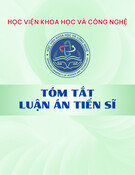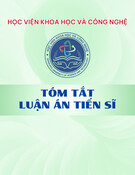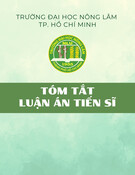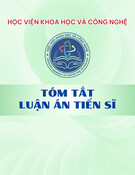
1
INTRODUCTION
1. The urgency of thesis
Maize (Zea mays L.) is one of three most important cereal grains which
provide food for human and livestock. In addition, maize is also a foodstuff
crop providing baby maize ear as high-ranking vegetable, white maize, sweet
maize for eating freshly, making maize milk and drinks and canned foods. In
addition, maize also provides material for factories producing food, foodstuff,
pharmaceutical products, and light industry, especially ideal materials for
biological energy. Maize is also the valuable agricultural commodity for
export, and brings foreign currencies for many countries and territories.
Maize was brought into our country about 300 years ago (Ngo Huu Tinh,
2009) and among food plants, maize is ranked in the second position after
rice. However, the maize yield of our country is still lower than average yield
of the world, for example: In 2013, its average yield was 4.43 tons/ha in
comparison with 5.52 tons/ha average yield of world, equally to 80.25%
(General Statistics Office of Vietnam, 2014); In 2018, it reached 4.72 tons/ha
in comparison with 5.92 tons/ha, equally to 79.7% (General Statistics Office
of Vietnam, 2019; FAO, 2018). About domestic maize yield, although the
speed increases rather fast, it still does not satisfy because the consumption
demand increases highly, for example, in the crop year 2016/ 2017, the maize
demand of our country was 12.9 million tons, we imported 8.5 million tons of
maize; in the crop year 2019/ 2020, the demand was 15.4 million tons, we
imported 11.5 million tons (USDA, 2020). Therefore, we can see that the
increase of domestic maize yield for satisfying domestic demand and limiting
import is a challenge of agriculture. However, about area, the maize planting
regions with big area and maize yield are currently narrowed, because several
other plants with higher economic value replace a part of maize area
(typically as Son La). Consequently, in addition to utilizing absolutely regions
where maize can be planted, it should apply the modern, synchronous
mechanizing; crop re-structuring, technological progress applying, variety
breeding and selecting methods should be applied to have new seeds suitable
to each crop and ecological region to have high yield and big maize output.
The winter crop after two rice crops in Red River Delta is an especially
specific crop. After ending the winter rice crop, a part of this rice area will be
used to plant vegetable plants, the most of left area is usually not used. This is
an opportunity to increase the maize planting area, to increase the maize yield
in area with two rice crops in the Northern provinces; especially, now the
Ministry of Agriculture and Rural Development has a guideline of developing
biomass maize as green food for breeding animal in the winter crop in the
Northern provinces. However, during the production process of Winter Crop,
the temperature increases gradually in the final months of year, in some years,
the temperature decreased to lower than 15
o
C and the cold spell could
lengthen for several weeks, which has significant impacts on plant production
in general and maize production in particular. Therefore, to develop strongly































